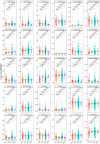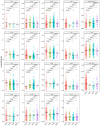The interaction of p53 and DNA repair gene mutations and their impact on tumor mutation burden and immune response in human malignancies
- PMID: 35530277
- PMCID: PMC9077057
The interaction of p53 and DNA repair gene mutations and their impact on tumor mutation burden and immune response in human malignancies
Abstract
P53 suppresses tumorigenesis through multiple cellular functions/mechanisms, including genomic stability surveillance. Recently, it has also be reported for its role in cancer immune response modulation. Deficiency in DNA repair pathways lead to the accumulation of genomic alterations and tumor mutation burden and in consequence resulting in the activation of immune response. We investigated the interaction of p53 and DNA repair gene mutations and their impact on tumor mutation burden and immune response in human malignancies by mining cBioPortal data of a range of human cancers. We found that in the majority of human cancers, p53 mutations are equally distributed between DNA repair gene mutation positive and negative cases and in a number of human cancers, p53 and DNA repair gene mutations have a tendency of co-occurrence. Only in colorectal cancer, there is a tendency of 'mutual exclusivity' of mutations in p53 and DNA repair genes. In most tumors, p53 and DNA repair gene mutations have synergistic/additive effect in increasing tumor mutation burden, but not in colorectal cancer where they are mutually exclusive. The impact of p53 and DNA repair gene mutations and their interaction on tumor microenvironment immune cells are complex and tumor type specific and not always correlated with tumor mutation burden. In colorectal cancers, these two types of mutations resulted in similar immune cell subpopulation changes and in tumors where the mutations have a tendency of co-occurrence, p53 showed dominant roles on immune response, although they can also counter-act each other for their effect on certain immune cell subtypes.
Keywords: DNA repair gene; Gene mutation; P53; tumor infiltrating immune cell population; tumor mutation burden.
AJCR Copyright © 2022.
Conflict of interest statement
None.
Figures




Similar articles
-
p53 tumor suppressor gene status and the degree of genomic instability in sporadic colorectal cancers.J Natl Cancer Inst. 1996 Nov 20;88(22):1665-70. doi: 10.1093/jnci/88.22.1665. J Natl Cancer Inst. 1996. PMID: 8931611
-
Mutation analysis of p53, K-ras, and BRAF genes in colorectal cancer progression.J Cell Physiol. 2005 Aug;204(2):484-8. doi: 10.1002/jcp.20310. J Cell Physiol. 2005. PMID: 15702478
-
P53 mutations in thyroid carcinoma: tidings from an old foe.J Endocrinol Invest. 2001 Jul-Aug;24(7):536-45. doi: 10.1007/BF03343889. J Endocrinol Invest. 2001. PMID: 11508790 Review.
-
The specificity of p53 mutation spectra in sunlight induced human cancers.J Photochem Photobiol B. 1995 May;28(2):115-24. doi: 10.1016/1011-1344(95)07130-t. J Photochem Photobiol B. 1995. PMID: 7636632 Review.
-
Unraveling the Role of TP53 in Colorectal Cancer Therapy: From Wild-Type Regulation to Mutant.Front Biosci (Landmark Ed). 2024 Jul 25;29(7):272. doi: 10.31083/j.fbl2907272. Front Biosci (Landmark Ed). 2024. PMID: 39082342 Review.
Cited by
-
PD-L1 expression in tumor and inflammatory cells is associated with favorable tumor features and favorable prognosis in muscle-invasive urothelial carcinoma of the bladder not treated by immune checkpoint inhibitors.BMC Urol. 2024 Apr 24;24(1):96. doi: 10.1186/s12894-024-01482-z. BMC Urol. 2024. PMID: 38658905 Free PMC article.
-
Germline-Somatic Interactions in BRCA-Associated Cancers: Unique Molecular Profiles and Clinical Outcomes Linking ATM to TP53 Synthetic Essentiality.Clin Cancer Res. 2025 May 1;31(9):1730-1745. doi: 10.1158/1078-0432.CCR-24-2058. Clin Cancer Res. 2025. PMID: 40019487
-
PPIH as a poor prognostic factor increases cell proliferation and m6A RNA methylation in hepatocellular carcinoma.Am J Cancer Res. 2024 Aug 25;14(8):3733-3756. doi: 10.62347/NZIJ5785. eCollection 2024. Am J Cancer Res. 2024. PMID: 39267679 Free PMC article.
References
-
- Cheok CF, Verma CS, Baselga J, Lane DP. Translating p53 into the clinic. Nat Rev Clin Oncol. 2011;8:25–37. - PubMed
-
- Valente LJ, Gray DH, Michalak EM, Pinon-Hofbauer J, Egle A, Scott CL, Janic A, Strasser A. p53 efficiently suppresses tumor development in the complete absence of its cell-cycle inhibitory and proapoptotic effectors p21, Puma, and Noxa. Cell Rep. 2013;3:1339–1345. - PubMed
LinkOut - more resources
Full Text Sources
Research Materials
Miscellaneous
